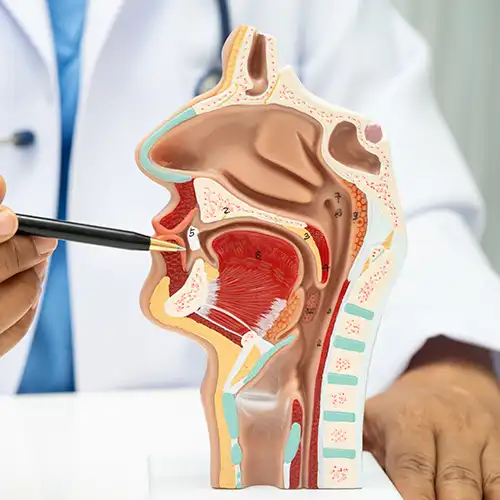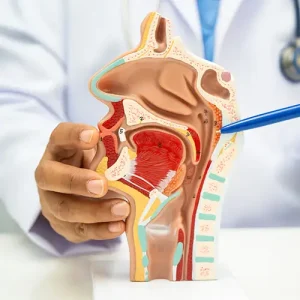Turbinate reduction surgery, also known as turbinoplasty, is a procedure designed to improve nasal breathing by reducing the size of the inferior turbinates. Enlarged turbinates are a common cause of chronic nasal obstruction.
Often performed alongside septoplasty to correct a deviated septum, the procedure can help restore clear nasal airflow when other measures, such as steroid nasal sprays or allergy treatments, have not been effective.
The aim is to reduce turbinate size while preserving the delicate mucosal lining, ensuring the nose continues to filter, warm and humidify the air you breathe.
By relieving nasal obstruction, turbinoplasty can make a significant difference, improving nasal breathing, supporting better sleep, energy levels and overall quality of life.


Turbinoplasty surgery is primarily used to treat conditions that cause chronic nasal obstruction due to enlarged (hypertrophic) turbinates. By reducing the size of the inferior turbinates while preserving their important function, turbinoplasty can help restore a clear nasal airway, improve breathing and relieve many symptoms linked to these conditions.
Some people experience persistent nasal blockage even after trying steroid sprays, antihistamines or decongestants. When congestion is caused by enlarged inferior turbinates rather than temporary inflammation, medication alone may not provide lasting relief. Turbinoplasty can address the underlying structural problem, restoring normal airflow.
Allergic rhinitis occurs when allergens such as pollen, dust mites or pet dander trigger the nasal lining to swell. Over time, repeated allergic reactions can cause the turbinates to remain enlarged, leading to ongoing nasal obstruction. Surgery may be recommended when allergy management and medications are not enough to control symptoms. Turbinate reduction may be discussed for patients also considering sinus surgery or rhinoplasty.
Non-allergic rhinitis is similar to allergic rhinitis but is not triggered by allergens. Instead, everyday irritants like cigarette smoke, air pollution, strong odours or sudden temperature shifts can cause the nasal lining to swell. Chronic swelling may lead to permanent turbinate enlargement, which may be relieved through turbinoplasty.
In some cases of chronic sinusitis, the sinuses themselves are not the only problem; enlarged turbinates also restrict airflow and drainage. This can trap mucous and lead to ongoing sinus infections. Reducing the size of the turbinates can help open the nasal passages, improving sinus ventilation and reducing the severity of symptoms.
A deviated septum occurs when the thin wall between the nostrils is displaced to one side, narrowing one or both nasal passages. When combined with enlarged turbinates, this can cause significant nasal obstruction. Surgeons often perform turbinoplasty alongside septoplasty to straighten the septum and create more space for airflow.
Repeated nasal infections or physical injury to the nose can cause the turbinate tissue to thicken permanently. This structural enlargement does not usually respond to medication. Turbinoplasty can reduce the tissue size while preserving function, allowing the nose to work normally again.

Before recommending surgery, Complete ENT explores non-surgical options, which may include:
For some patients, these treatments provide adequate relief. However, for those with persistent nasal obstruction despite medical management, turbinate reduction surgery may offer a better long-term solution.

The turbinates are small, curved structures inside the nasal cavity that perform an essential role in respiratory health. They help filter out dust, trap allergens and add warmth and moisture to inhaled air.
The inferior turbinates are located along the lower part of the nasal passages and are the most common site of obstruction.
These turbinates can become enlarged (i.e. hypertrophic) due to:
When enlarged, the turbinates can block airflow and cause symptoms such as:
Understanding their function is vital in determining whether surgery is the most appropriate step for restoring nasal airflow.

This is one of the most widely performed techniques and is valued for its long-term effectiveness. In a submucosal resection, the surgeon removes a small portion of bone and soft tissue from inside the turbinate, while leaving the thin outer mucosal lining intact. This preserves the turbinate’s important role in filtering and humidifying air, while creating more space in the nasal passageway. Many patients notice significant, lasting improvements in breathing after recovery.
Radiofrequency turbinate reduction is a minimally invasive option that can often be performed under local anaesthetic. A fine probe delivers gentle thermal energy into the turbinate tissue, causing it to shrink over time. Because the procedure is done internally and the mucosal lining is preserved, recovery is usually quick, with minimal discomfort. This technique can be an excellent choice for patients seeking a shorter, less invasive procedure.
Your aftercare directions from your ENT surgeon should be followed accurately to support optimal results and help prevent serious complications.
Your aftercare may include:
Most people recover well after turbinate reduction surgery, but it’s important to know when to seek medical advice. You should contact your ENT surgeon or healthcare provider promptly if you experience:
Turbinate reduction surgery can be life-changing for patients living with chronic nasal obstruction. By improving airflow and reducing congestion, it helps restore comfortable breathing, better sleep and potential for a more active lifestyle.
If you are experiencing ongoing nasal blockage despite medical treatment, the next step is to book a consultation with an experienced ENT surgeon. At Complete ENT, we provide a full assessment, explain your treatment options and recommend a personalised plan for lasting relief.


Call us on
07 3905 5999